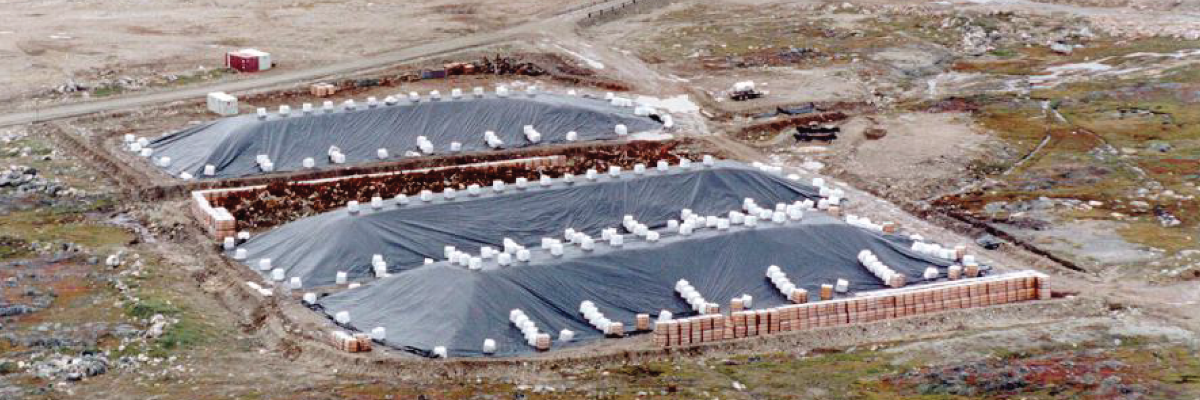By Rohit Sati, M.Sc / Product Manager – Containment and Enclosure Systems
A typical deployment of geomembranes (liners) occurs in a wide range of temperatures, from very hot to very cold. As the installation conditions get colder, all geomembrane materials become stiffer and more challenging to handle. For most geomembranes, typical deployment methods will work in temperatures down to about freezing. In some applications, such as oil field frac tank liners, the job may need to continue in all weather. This tech note discusses liner deployment in the extreme cold (typically less than 0°F or -18°C). Layfield’s frac tank liners are made with Enviro Liner® products which are as good or better in the cold than any other lining material on the market. Enviro Liner® products are made to exacting standards, produced and fabricated in a state-of-the-art facility, and tested to meet demanding quality standards. Enviro Liner® is an excellent material for extremely cold temperatures; however, additional handling procedures and care of the liner are required during deployment and installation.
Cold Temperature Deployment Issues
- Flexibility. The biggest issue with deployment at extremely low temperatures is the loss of flexibility. In tests at -40°C (-40°F), we have seen that liner materials have only 16% of the flexibility they would typically have at room temperature. This loss of flexibility makes it more difficult to unroll and can make the material stiff. The warmer you can keep the material during deployment, the more flexible and easier it will be to deploy.
- Shrinkage. A side-effect of the loss of flexibility is that the material appears to shrink. The actual measured shrinkage of Enviro Liner® is minor, about 1% for a change between room temperature and -30°C to -40°C (-22°F to 40°F). You may notice more shrinkage than this due to the stiffness of the wrinkles in the liner that will not lay flat in the cold. You may need to take a larger liner to the site as you need 2% to 3% more liner material in extremely cold conditions.
- Subgrade Problems. In cold weather, getting the subgrade prepared is more challenging, which could lead to problems with damage. Ice and snow on the subgrade can hide loose rocks that could damage a liner.
- Drainage Sumps. When the weather is warm, the liner can easily conform to the changes in grade at a steeply cut drainage sump (sometimes called the “chicken foot”). As the liner becomes stiff in the cold, it will not easily drape into these sumps. In severely cold conditions, the drainage sump should be cut with a gentler grade to allow the liner to make the bend more easily.
- Base of the Wall. When placing the liner at the base of the wall, it is vital to get the liner into the right-angle corner tightly to prevent bridging. As the weather gets colder this becomes more complex, and extra time should be planned to accomplish this task. It is also essential that the liner not be kicked at this point – kicking the liner into the wall at warmer temperatures may be OK, but the colder it gets, the more care needs to be taken.
- Wind Damage. If the wind gets a hold of a liner, it can cause damage at any temperature. Holding the liner in place with ballast during installation is very important. In freezing weather, using water as ballast is sometimes not practical. Layfield has sand tubes available for ballast, which may be more suited to cold-temperature installations.
Once temperatures fall below -18°C (0°F), all types of construction become much more difficult. This is also true with liner installations. A typical frac tank installation requires a fabricated panel of liner material that weighs about 3,000 lbs (1,500 kg). Often the liner panel has been stored outside for weeks before use. Liner materials are pretty good insulators, so if this panel has become cold-soaked, it will be stiff and difficult to unroll, even if the temperatures are warmer on the day of installation. Here are a few things we do to make it easier to install liners on extremely cold days.
Cold Temperature Installation Practices
- Warm the Liner. The best practice is to keep the liner in a heated storage area for at least 8 hours on the day before installation. Another method is to put the fabricated liner under a tarp and set up a heater and ducting to warm the panel. Putting tomorrow’s liner in the shop overnight will make installing the next day in the cold much more manageable.
- Go thicker. A thicker liner material has more strength and will hold up to rough handling better. Our cold temperature handling testing found that Enviro Liner® 40 mil (1.0mm) was much harder to damage than 30 mil (0.75mm) liner material.
- Take it Easy. Don’t stress the liner quite so hard when it’s frigid. Unroll the liner along the ground instead of pulling it with a crane. Use a few more people to pull. Don’t kick the liner into the wall.
Enviro Liner® materials are by far the most economical and durable materials for frac tank lining applications, but the materials do become more prone to installation damage in extremely cold temperatures. When the temperature starts to fall below -18°C (0°F), extra care and precautions are required to ensure the liner is installed correctly so that it works as intended.
Related Articles
View All News









